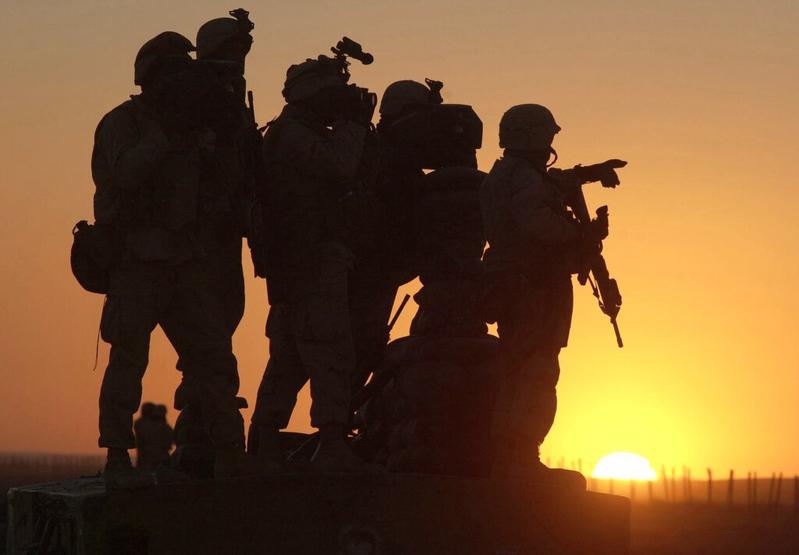 FILE - In Jan 14, 2002 file photo, US Marines scan the northwest perimeter of the American military compound at Afghanistan's Kandahar airport using sophisticated thermal imagery equipment. (MARCO DI LAURO, FILE / AP)
FILE - In Jan 14, 2002 file photo, US Marines scan the northwest perimeter of the American military compound at Afghanistan's Kandahar airport using sophisticated thermal imagery equipment. (MARCO DI LAURO, FILE / AP)
The United States military deployed forces into Afghanistan after the Sept 11, 2001 terrorist attacks. By that date, two decades later, the troops will be withdrawn.
The withdrawal of the remaining 2,500 US troops would conclude the longest war in US history.
The need for a continued military presence in Afghanistan has long been a contentious issue in US politics, particularly in light of the killing in 2011 of al-Qaida mastermind Osama bin Laden in Pakistan in a raid by US Navy Seals.
The decision also defies a May 1 deadline for full withdrawal under a peace agreement the Trump administration reached with the Taliban last year, but leaves no room for additional extensions. A senior Biden administration official called the September date an absolute deadline that will not be affected by security conditions in the country.
“The president has been consistent in his view that there’s not a military solution to Afghanistan —that we have been there for far too long,” Jen Psaki, White House press secretary, told reporters on April 13. “He also believes we need to focus our resources on fighting the threats we face today, almost 20 years after the war began.”
The Taliban, a Sunni Islamic political movement and military organization, however, does not support the extended deadline for withdrawal.
“We are not agreeing with delay after May 1,” Zabihullah Mujahid, a Taliban spokesman, said on local television. “Any delay after May 1 is not acceptable for us.”
More than 2,400 US troops have been killed and 20,000 wounded in a military operation that has cost nearly US$1 trillion to wage. The US troop presence in Afghanistan, a mountainous, landlocked country whose northeastern area borders China, peaked at more than 100,000 in 2011.
A study by Brown University estimated that 43,000 civilians have been killed in the ongoing conflict in Afghanistan. A United Nations report issued last year estimated that more than 35,000 civilians were killed from 2001 to 2019.
On Sept 11, 2001, al-Qaida-affiliated hijackers slammed passenger airliners into the World Trade Center in New York City and the Pentagon outside Washington. A fourth hijacked plane went down when passengers stormed the cockpit over Pennsylvania. The attacks led to nearly 3,000 dealths.
Disagreement over the withdrawal plan surfaced as soon as it was announced.
US Senator Jeanne Shaheen, a New Hampshire Democrat who sits on the Senate Foreign Relations Committee and a longtime advocate of women’s rights, said on Twitter on April 13 she was “very disappointed in @POTUS’ decision to set a Sept. deadline to walk away from Afghanistan” .
“Although this decision was made in coordination w/our allies, the US has sacrificed too much to bring stability to Afghanistan to leave (without) verifiable assurances of a secure future,” she wrote. “It undermines our commitment to the Afghan people, particularly Afghan women.”
Senate Minority Leader Mitch McConnell, Republican of Kentucky, accused the Biden administration of making a “grave mistake” to “turn tail and abandon the fight” in Afghanistan.
“It is retreat in the face of an enemy that has not yet been vanquished and abdication of American leadership,” he said on the Senate floor April 13. “Leaders in both parties, including me, offered criticism when the prior administration floated the concept of a reckless withdrawal from Syria and Afghanistan.”
Senator Lindsey Graham, a South Carolina Republican who repeatedly criticized the Obama administration’s withdrawal from Iraq and troop drawdowns in Afghanistan, said a full withdrawal was “dumber than dirt and devilishly dangerous”.
Senator Elizabeth Warren, a Massachusetts Democrat, said: “For nearly 20 years, we have adopted a costly war-based approach to national security and counterterrorism policy with no clear endgame. While our withdrawal comes years late, President Biden recognizes the reality that our continued presence there does not make the US or the world safer.”
On April 13, Senate Foreign Relations Chairman Robert Menendez, a Democrat from New Jersey, told reporters he wants to get troops home but is worried the US may “lose what we were seeking to achieve”.
“I certainly will not be supportive of any assistance to Afghanistan if there is backsliding on civil society, the rights that women have been able to achieve,” said Menendez, who also said he was concerned about the Taliban meeting its obligations.
The disclosure of the withdrawal plan came on the same day that the US intelligence community released a dim outlook on Afghanistan, warning that its government would struggle to hold the Taliban insurgency at bay if the US-led coalition withdraws support.
Intelligence analysts said that the prospects for a peace deal between the Afghan government and the Taliban “will remain low” for the coming year.
“Kabul (the capital) continues to face setbacks on the battlefield, and the Taliban is confident it can achieve military victory,” according to the report from the Office of the Director of National Intelligence.
David Petraeus, a retired US general and former CIA director, also has warned that the withdrawal “could prove quite catastrophic”.
“We shouldn’t be so US-centric as to think that just by withdrawing our forces that the war ends,” Petraeus said on the Voice of America’s Press Conference USA on April 6.
Ai Heping in New York and agencies contributed to this story.


